- Bernard Preston homepage
- Hummus
- Freezing Chickpeas
Freezing chickpeas
Freezing chickpeas really is a simple task. You are probably thinking that it is too much trouble and you'll just buy them in cans.
I did that for a while until some disconcerting facts began to emerge. Firstly, if you read the label, all sorts of chemicals have been added; sugar and salt too. And now there is disturbing evidence that the plastic that is used to line the cans causes malignant-disease.
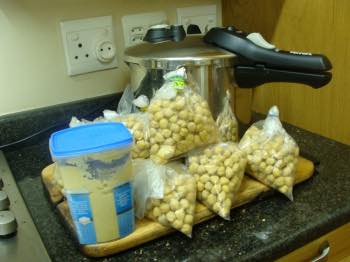
This page was last updated by Bernard Preston on 9th April, 2021.
I keep asking myself if I am becoming a neurotic, but, no, I do not want to increase the risk of getting tumours and autoimmune-diseases; it is already quite high enough already in my family. And in any case chickpeas are a quarter of the price if you process them yourself.
We use them as an alternative form of protein, adding them to our beef
and mutton-stews, and soups; and for our authentic hummus recipe, seen above,
and for making low GI bread. I also use them for thickening for our green chilli, for example, instead of refined cornstarch.
It takes about fifteen-minutes of your actual time, once a month, to cook and freeze your chickpeas. That's not too bad.
Two of the steps however do take time, but you don't have to sit and watch them imbibing water. Just start the process and go to bed. Once the pressure-cooker is beginning to spurt steam, turn it down and do something else for half an hour.
Freezing chickpeas
Freezing chickpeas is a simple task taking no more than fifteen-minutes of your time.
I'm as sad as the rest of you about the research concerning red-meat. Up to a point you can have your steak and eat it; by adding plenty of vegetables and salads to your dinners.
But in the end we need to be enjoying smaller portions of red meat, and having vegetable-protein substitutes; chickpeas are my favourite and soya beans the least.
In a sense our chickpeas are our alternative to minimally-processed plant protein about which doubts remain in the literature.
Broad-beans are my favourite green legume; and they have the largest amount of vegetabkle protein; about a quarter.
The process can be divided up into five individual steps, none of them arduous or time-consuming, and made a great deal easier with a pressure cooker.
Otherwise they take a long time to cook.
- Soak the chickpeas overnight; rinse
- Pressure-cook
- Rinse
- Drain
- Freeze
You start off by locating dried chickpeas, or garbanzo-beans as they are sometimes called; that incidentally may be the most difficult part of the process. I purchase at least half a dozen packets at a time.
A kilogram, costing less than two-dollars, lasts us about a month. Hummus really makes a salad and if you love baking bread as I do, then a dollop turns your loaf into low GI.
Let's look at these individual steps.
Soak the chickpeas
To soak the chickpeas simply pour a couple pounds of the dried-legumes into a large pot, cover generously with water, and go to bed; I use the pressure cooker. That chore takes me all of two minutes in the evening; not too onerous, eh?
Next morning you will discover they've swollen to double the size, and you may have to add more water.
It's worth rinsing and draining them once or twice; folk say they give less gas, but in fact we have no trouble.
It also inhibits the work of any phytates in the chickpeas; they inhibit the absorption of minerals. That's another two-minutes of your time taken up. Pour off all the surplus water.
One little advantage is all that water they absorbe; together with all the natural fibre in chickpeas, you'll find that your woes on the toilet are likely to be a matter of the past, or least half-way there.
More water and extra fibre are the solution to chronic-constipation.
Cook your chickpeas
To cook your chickpeas, I make a plea for a pressure-cooker, otherwise they take a long hour and a half of slow boiling; and often bubble over and make a mess.
Add plenty of boiling water, almost covering the chickpeas as they seem to go on absorbing the liquid during cooking. Bring them up to pressure, and get on with something else for twenty-minutes.
That might take you five-minutes; nine in total so far.
Turn off the heat, and start your breakfast. Once the pressure has dropped, add plenty of fresh cold-water, and rinse them several times to remove more of the phytates.
Here are more details about other ways of cooking chickpeas; fermenting them for example.
Consider too the glycemic response to legumes should you be concerned about their starch content.
Newsletter
Our newsletter is entitled "create a cyan zone" at your home, preserving both yourself and Mother Earth for future generations; and your family too, of course. We promise not to spam you with daily emails promoting various products. You may get an occasional nudge to buy one of my books.
Here are the back issues.
- Lifestyle and ideal body weight
- What are ultra-processed foods?
- Investing in long-term health
- Diseases from plastic exposure
- Intensive lifestyle management for obesity has limited value
- A world largely devoid of Parkinson's Disease
- The impact of friendly bacteria in the tum on the prevention of cancer
- There's a hole in the bucket
- Everyone is talking about weight loss drugs
- Pull the sweet tooth
- If you suffer from heartburn plant a susu
- Refined maize meal and stunting
- Should agriculture and industry get priority for water and electricity?
- Nature is calling
- Mill your own flour
- Bake your own sourdough bread
- Microplastics from our water
- Alternative types of water storage
- Wear your clothes out
- Comfort foods
- Create a bee-friendly environment
- Go to bed slightly hungry
- Keep bees
- Blue zone folk are religious
- Reduce plastic waste
- Family is important
- What can go in compost?
- Grow broad beans for longevity
- Harvest and store sunshine
- Blue zone exercise
- Harvest and store your rainwater
- Create a cyan zone at your home
Drain your chickpeas
To drain your chickpeas use an ordinary colander; it's not critical that they are completely dry, but it does make it easier to separate the frozen seeds if you want only half a packet, for example.
Rinsing and draining could take you up to five-minutes. I do it at least three times; those phytates.
Freezing chickpeas
Freezing chickpeas at last has arrived; you've no doubt been wondering when I would get there.
Using a small plastic-cup, scoop your cooked chickpeas into packets and tie them with a rubber band; we now use clothes pegs. Drop them into the deep freezer.
This made seven generous packets from a kilogram of dried garbanzo-beans, as they are sometimes called. Keep one of them back to make your first "quick hummus."
Copy and paste into Site Search for more information.
So fifteen minutes or a little longer, once a month is all it takes; it is a very small chore, and will significantly boost the family's well-being.
Nutritious choice foods
Choice-foods, made with a minimum of effort is what my Bernard Preston site is all about; freezing chickpeas is one tiny part of the whole.
It's not sensible, nor even possible to rate one vegetable over another; they all have their virtues, many of the specifics not yet revealed. But chickpeas score very highly on my list of choice foods because they enable us to reduce our reliance on red meat for protein; that will also help to save the planet from the ravages of climate-change.
Freezing chickpeas simply reduces the hassle-factor; using them becomes so easy.
Processed red meat is the real devil; avoid it at all costs if you value your well-being. Sadly that means bacon and ham too; keep them for high and holy days only.
And unlike soya beans, chickpeas are very nice; they aren't the world's favourite vegetable high in protein for nothing. We eat them virtually every day in one way or another. Hummus is often the most popular.
Do you see that dollop of hummus below? It really makes a salad, together with a squirt of olive oil and fresh lemon-juice.
Interestingly I have been eating corn on the cob every-day for the past month and haven't put on an ounce. Fresh from the garden they are a delight; whole grains in moderation are not fattening.
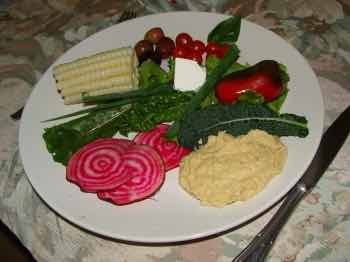
Though the critics rave about raw beets, I prefer to turn them into borscht. Bernie's beetroot soup is another dream; slow food, made fast. There again you need that pressure cooker, or they take an age. Greenies like us can do it using solar power; you could too, but that is a big home-project.
Solar pressure cooking is just as easy on the induction-stove, or any hob in fact.
Low GI bread
Low GI bread with added hummus is so easy; it takes me five-minutes to mix the dough. By freezing chickpeas you just make the process more simple and quicker.
Since we make a large-tub of hummus twice a week using this freezing chickpeas technique, it's so easy to add a tablespoon or two to the dough.
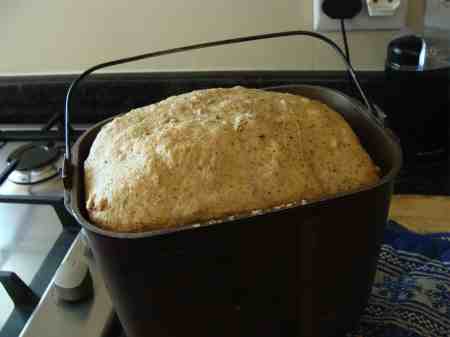
To reduce the glycemic-index of any food, simply add fat and protein. To make low GI bread, I just mix in a couple tablespoons of hummus, and a dollop of butter to the dough.
If you make sourdough, then add the hummus the next morning just before starting the bread-machine; it goes off quickly.
In fact on the fourth-day, the last of it always goes into the sourdough recipe; it doesn't keep.
I've discovered there is a marvelous synergy of green living; having a pressure-cooker for the dried beans, means you also have a ready source of frozen chickpeas available for hummus, which greatly improves the taste and nutrition of your homemade bread.
Interestingly, with your salad, a smear of raw honey on 100pc wholemeal bread actually helps lose weight. The pollen-granules get through the light filter; that is where the bees get their protein and fat.
In the context of the whole meal, a little natural honey, a teaspoon or two, has little glycemic affect. That research was done on completely unprocessed nectar; I can't vouch for the stuff from the supermarket.
Have no concern about the phytates in wholemeal-flour and chickpeas; they do bind small amounts of iron and zinc for example, but in the overall context of our food the effect is minimal. Would you rather get all your protein from red meat?
Are phytates bad? To find out copy and paste into Site Search.
Authentic hummus recipe
Authentic hummus recipe is a chore if you don't have the frozen legumes readily available. Since we enjoy hummus almost every day with our salads, freezing chickpeas is a task for every month.
It's so quick and easy, and this hummus recipe is equally simple.
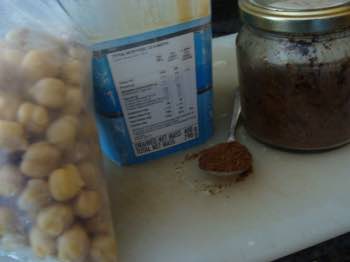
Useful links
- Canned versus dried-chickpeas.
- Solar pressure-cooking.
- Garbanzo beans research at WHF
- Freezing broad beans
When browsing use right click and "Open Link in New Tab" or you may get a bad gateway signal.
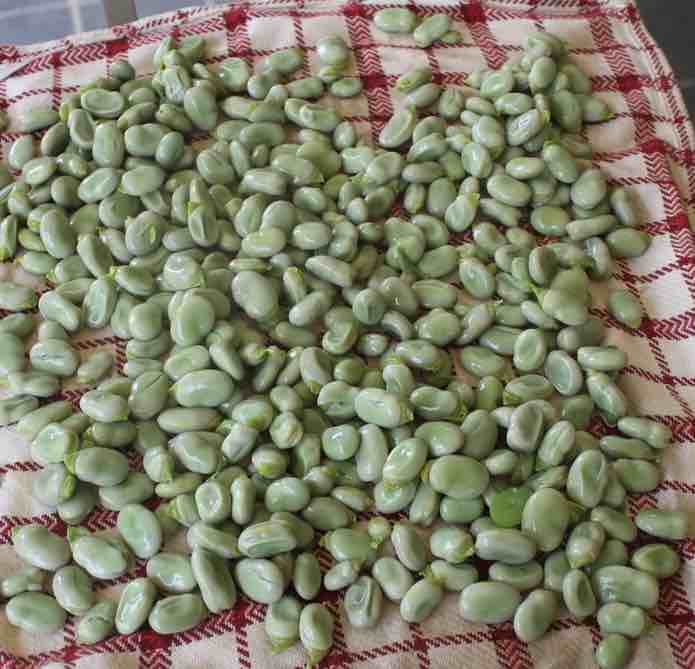
When browsing use right click and "Open Link in New Tab" or you may get a bad gateway signal.
Did you find this page interesting? How about forwarding it to a friendly book or food junkie? Better still, a social media tick would help.
- Bernard Preston homepage
- Hummus
- Freezing Chickpeas
Address:
56 Groenekloof Rd,
Hilton, KZN
South Africa
Website:
https://www.bernard-preston.com